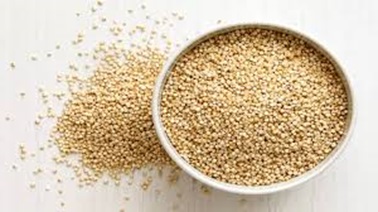Is Quinoa Good for Weight Loss? All You Need to Know
Is Quinoa Good for Weight Loss? All You Need to Know
Quinoa, often referred to as a pseudo-cereal, has seeds that can be milled and ground into flour, similar to traditional grains and cereals.

Unlike true cereals, pseudo-cereals like quinoa are not grasses but can still be processed into flour.
Quinoa is celebrated for its wholegrain properties. It can be consumed without processing or refining, retaining its fiber content and nutritional benefits.
Quinoa has a rich history, having been cultivated for over 5,000 years.
It has been a staple crop in Peru, Bolivia, Northern Chile, and the Andean cultures of present-day Colombia and Ecuador.
In the Inca Empire, quinoa was so significant that the emperor would ceremonially plant the first seeds each year.
In the 1500s, Spanish explorers noted widespread quinoa cultivation in the Andes. Attempts to bring quinoa seeds to Europe failed, and the Spanish, aiming to suppress local cultures, tried to end its cultivation.
This led to a significant decline in quinoa production for centuries. However, in the 1970s, quinoa experienced a resurgence, and today its cultivation is highly advanced.
The growing global interest in healthy eating drives demand for nutritious alternatives like quinoa, which remains a popular choice in the organic food market.
Quinoa for Weight Loss: Health Benefits of Quinoa
Quinoa comes in various varieties, with white, red, and black quinoa being the most common in the mainstream market.
The choice of quinoa variety often depends on the intended use, such as in soups, salads, or flour.
The USDA recommends that at least half of the grains in daily meals should be whole grains.
Unlike refined grains, which lose most of their fiber, iron, and vitamins during processing, whole grains like quinoa retain these essential nutrients.
Including whole grains in your diet can help lower the risk of chronic diseases such as diabetes, heart disease, and cancer.
Quinoa and quinoa flour are excellent sources of several vital nutrients, including folate, iron, thiamine, copper, magnesium, manganese, phosphorus, potassium, zinc, and other trace elements.
Nutritional Information (per half-cup of cooked quinoa):
- Calories: 111
- Protein: 4 grams
- Carbohydrates: 20 grams
- Fiber: 3 grams
- Fat: 2 grams
- Sugar: 1 gram
Quinoa’s rich nutritional profile makes it a valuable addition to a healthy diet, contributing to overall well-being and disease prevention.

Quinoa: A Powerful Ally for Weight Loss
Quinoa is one of the few plant-based foods considered a complete protein, containing all nine essential amino acids.
These amino acids are the building blocks of proteins essential for the muscles, bones, skin, and blood. Since the body cannot produce or store these amino acids, they must be obtained from food daily.
Quinoa has a high protein-to-carbohydrate ratio compared to other grains, making it an excellent choice for vegetarians and those on a gluten-free diet.
Unlike many gluten-free foods made with potato or rice, which lack a complete nutritional profile, quinoa is nutrient-dense and serves as a great wheat replacement without sacrificing nutritional value.
This is why quinoa is gaining popularity among those aiming to lose weight. Replacing wheat-based or gluten products with quinoa has shown better results for many Weight Watchers.
Quinoa’s complex carbohydrates and low glycemic index help with long-term weight management, as it provides a slow release of energy, preventing blood sugar spikes.
It’s so nutritious that NASA uses it to feed astronauts on long space missions!
How Quinoa Helps in Weight Loss
High Fiber Content: Quinoa is rich in dietary fiber, with cooked quinoa containing about five grams of fiber per cup.
High-fiber foods are crucial for weight loss because they increase the feeling of fullness, helping you eat less and avoid snacking between meals.
Fiber also aids digestion, promotes regular bowel movements, and supports healthy gut bacteria growth, which can influence weight loss.
High Protein Content: Quinoa’s high protein content helps reduce food cravings and overall calorie intake.
With eight grams of protein per cooked cup, quinoa provides all nine essential amino acids.
Protein is essential at every meal as it requires extra calories to digest and process, thus boosting the weight loss process.
Low Glycemic Index: Quinoa’s low glycemic index helps with blood sugar management, providing a slow release of energy and preventing sudden blood sugar spikes and crashes.
This steady energy release supports long-term weight management.
Gut Health: The fiber in quinoa promotes the growth of healthy gut bacteria, which play a role in weight management.
A healthy gut microbiome can aid in weight loss and overall health.
Satiety and Metabolism: The combination of fiber and protein in quinoa increases satiety and metabolism.
This means you feel full longer and your body burns more calories during digestion, aiding in weight loss.
Swapping traditional grains like wheat and rice with quinoa can be a minor dietary change with significant benefits for weight loss. Its rich nutritional profile, high fiber and protein content, and low glycemic index make quinoa a powerful ally in reaching your weight loss goals.
Quinoa: A Nutrient-Dense Ally for Vegetarians and Weight Loss
Vegetarians often seek protein-rich, plant-based foods that provide all essential nutrients.
Quinoa fits this bill perfectly, making it an excellent choice for weight loss and filling nutritional gaps.
Despite its bulk, quinoa is calorie-dense, providing a feeling of fullness and aiding in weight loss.
As nutritionists and researchers say, “more volume = more satiety + resultant weight loss.”
Loaded with vitamins and minerals, quinoa is particularly high in manganese, which supports bone health, reduces inflammation, and lowers the risk of disease due to its antioxidant properties.
Manganese also plays a crucial role in hormone health, especially thyroid function. A diet deficient in manganese can lead to hypothyroidism, causing hormone imbalances and weight gain.
Moreover, manganese is linked to lower levels of abdominal obesity.
Quinoa’s low glycemic index (GI) makes it a safe choice for individuals with diabetes, as it helps control blood sugar levels.
This combination of satiety, nutritional value, and low GI makes quinoa an excellent choice for weight-conscious individuals.
Cooking Quinoa for Weight Loss
Quinoa has a natural coating called saponin, which is bitter. To remove this, the grains need to be rinsed well and soaked.
Cooked quinoa has a nutty flavor that enhances salads, stir-fried vegetables, or even crusts for bakes.
Incorporating quinoa into your diet is easy. Quinoa flour is a nutritious replacement for wheat in baked goods like cakes, breads, cookies, and pancakes.
Quinoa’s versatility makes it an excellent substitute for rice, pasta, and other starchy foods.
For those who engage in heavy workouts and prefer vegetarian meals, quinoa’s protein content supports muscle building and strength.
Quinoa can be cooked in under 15 minutes and can be used in a variety of dishes, such as salads, soups, or even biryani.
It can be flavored with herbs and spices or cooked in low-sodium vegetable stock for added flavor.
For a weight-loss-friendly breakfast, quinoa can be cooked into a sweet porridge with chia seeds, milk, and fruit.
Quinoa can also be popped like popcorn, seasoned, and enjoyed as a snack, or used in homemade granola or chiwda.

Conclusion
Whether you choose white, red, black, or multi-colored quinoa, this versatile grain helps with weight loss in numerous ways and can be incorporated into a variety of recipes.
Quinoa’s nutritional benefits and ease of preparation make it a valuable addition to any diet.


